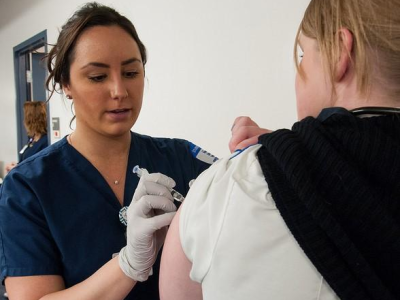Phase 2 data support bedaquiline-delamanid combo for resistant TB
The results of a National Institutes of Health-funded phase 2 study indicate the new tuberculosis (TB) drugs delamanid and bedaquiline, when combined, have only a modest effect on the electrical activity of the heart, US, South African, and Peruvian researchers reported last week in the Lancet Infectious Diseases.
In the phase 2 randomized controlled trial, patients in South Africa and Peru with multidrug-resistant or rifampicin-resistant TB were randomized 1:1:1 to receive bedaquiline, delamanid, or both for 24 weeks. The two new drugs are considered critical components of a shorter, less toxic regimen for multidrug-resistant and rifampicin-resistant TB, but the cardiac and microbiologic safety of combining the two has not been well-established.
Both drugs are known to cause modest QTc prolongation, which can lead to an irregular heartbeat and increase the risk of sudden cardiac arrest, but the combined effect on QTc-related cardiac risk is unknown.
A total of 84 participants were enrolled in the trial from August 2016 through July 2018, with 28 in each treatment group and patients with higher-than-normal QTc values excluded. The primary endpoint was mean QTc change from baseline, as measured by electrocardiogram.
The mean change in QTc from baseline was 12.3 milliseconds (ms) in the bedaquiline group (95% confidence interval [CI], 7.8 to 16.7), 8.6 ms in the delamanid group (95% CI, 4.0 to 13.1), and 20.7 ms in the combined group (95% CI, 16.1 to 25.3). There were no grade 3 or 4 (life-threatening) QTc prolongation events, and the maximum QTc increase seen was similar for bedaquiline plus delamanid versus bedaquiline alone.
"These results are reassuring and provide evidence of the safety of concurrent bedaquiline and delamanid use in patients with multidrug-resistant or rifampicin-resistant tuberculosis," the authors wrote.
In addition, exploratory analysis found high rates of 8-week culture conversion in all groups, with early and sustained culture results seen in the combined treatment group. The authors said this is an encouraging sign that the combined treatment is effective but noted that the finding needs to be confirmed in larger clinical trials.
Feb 12 Lancet Infect Dis abstract
Multistate Listeria outbreak linked with Hispanic-style cheese
A Listeria monocytogenes outbreak has hospitalized seven people in four states, the Centers for Disease Control and Prevention (CDC) said on Feb 12.
CDC investigators have traced the outbreak to Hispanic fresh- and soft-style cheeses, including queso fresco, queso blanco, and queso panela and are working to identify a singular brand or cheese type.
The affected states are Maryland (4 cases), Connecticut (1), New York (1), and Virginia (1), and whole-genomic sequencing has shown that the strains are closely related. The date of first symptoms extend from Oct 20, 2020, to Jan 22, 2021.
Patient ages range from 45 to 75, with a median age of 61. Of the four people the CDC has been able to interview, three said they ate at least one type of Hispanic-style fresh or soft cheese in the month before they got sick. No deaths have been reported.
Listeria symptoms include headache, stiff neck, confusion, loss of balance, convulsions, fever, and muscle aches. Symptoms start 1 to 4 weeks after eating the affected food, but onset could be the same day or at least 70 days later. The CDC recommends people only eat cheeses that have been made with pasteurized milk. Those at higher risk for Listeria, such as pregnant women, those 65 years or older, or those with compromised immune systems, should avoid the food group as a whole for now.
A 2018 CDC study reported that Listeria outbreaks associated with soft cheeses have risen in recent decades, with an 88% hospitalization rate and 17 deaths (9.4%) among 180 illnesses.
Feb 12 CDC outbreak notice
Neurologic problems noted in children with hemolytic uremic syndrome
Pediatric patients who develop hemolytic uremic syndrome (HUS)—a rare kidney failure that follows an Escherichia coli infection—are at risk for severe acute neurologic symptoms (ANS), according to a study based on almost 4,000 US patients. The findings were published today in Pediatrics.
The study was the largest to date to describe ANS following HUS, and showed a strong correlation between increased multiple neurological symptoms and mortality. The authors used the Pediatric Health Information System database to identify HUS-related inpatient visits between 2004 and 2018.
Among 3,915 patients included in the analysis, acute neurologic manifestation (ANM) was noted in 10.4% (409) patients, the authors found, and encephalopathy (245) and seizures (108) were the most common ANMs recorded. The median age for patients with at least one ANM was 3.3 years.
Mortality was significantly higher among patients with an ANM compared with patients without an ANM (13.9% vs 1.8%; P < .001). Brain hemorrhage (odds ratio [OR], 3.09; 95% confidence interval [CI], 1.40–6.82; P = .005), brain infarction (OR, 2.64; 95% CI, 1.10–6.34; P = .03), anoxic brain injury (OR, 3.92; 95% CI, 1.49–10.31; P = .006), and brain edema (OR, 4.81; 95% CI, 1.82–12.71; P = .002) were independently associated with mortality.
"Knowledge of these risk factors can help clinicians prognosticate clinical course and appropriately counsel families," the authors write.
Feb 15 Pediatrics study













